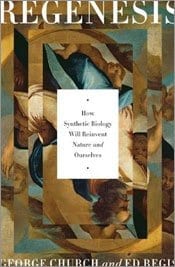Using next-generation sequencing technology and a novel strategy to encode 1,000 times the largest data size previously achieved in DNA, Harvard geneticist encodes his book in life’s language
Although George Church‘s next book doesn’t hit the shelves until Oct. 2, it has already passed an enviable benchmark: 70 billion copies — roughly triple the sum of the top 100 books of all time.
And they fit on your thumbnail.
That’s because Church, a founding core faculty member of the Wyss Institute for Biologically Inspired Engineering at Harvard University and the Robert Winthrop Professor of Genetics at Harvard Medical School, and his team encoded in DNA the book,Regenesis: How Synthetic Biology Will Reinvent Nature and Ourselves in DNA, which they then decoded and copied.
Biology’s databank, DNA has long tantalized researchers with its potential as a storage medium: fantastically dense, stable, energy-efficient and proven to work over a timespan of some 3.5 billion years. While not the first project to demonstrate the potential of DNA storage, Church’s team married next-generation sequencing technology with a novel strategy to encode 1,000 times the largest amount of data previously stored in DNA.
The team reports its results in the Aug. 17 issue of the journal Science.
The researchers used binary code to preserve the text, images and formatting of the book. While the scale is roughly what a 5 1/4-inch floppy disk once held, the density of the bits is nearly off the charts: 5.5 petabits, or 1 million gigabits, per cubic millimeter. “The information density and scale compare favorably with other experimental storage methods from biology and physics,” said Sriram Kosuri, a senior scientist at the Wyss Institute and senior author on the paper. The team also included Yuan Gao, a former Wyss postdoc who is now an associate professor of biomedical engineering at Johns Hopkins University.
And where some experimental media — like quantum holography — require incredible cold temperatures and tremendous energy, DNA is stable at room temperature. “You can drop it wherever you want, in the desert or your backyard, and it will be there 400,000 years later,” Church said.
Reading and writing in DNA is slower than in other media, however, which makes it better suited for archival storage of massive amounts of data, rather than for quick retrieval or data processing. “Imagine that you had really cheap video recorders everywhere,” Church said. “Just paint walls with video recorders. And for the most part they just record and no one ever goes to them. But if something really good or really bad happens you want to go and scrape the wall and see what you got. So something that’s molecular is so much more energy efficient and compact that you can consider applications that were impossible before.”
About four grams of DNA theoretically could store the digital data humankind creates in one year.
via Wyss Institute
The Latest Streaming News: Synthetic Biology updated minute-by-minute
Bookmark this page and come back often
Latest NEWS
Latest VIDEO








